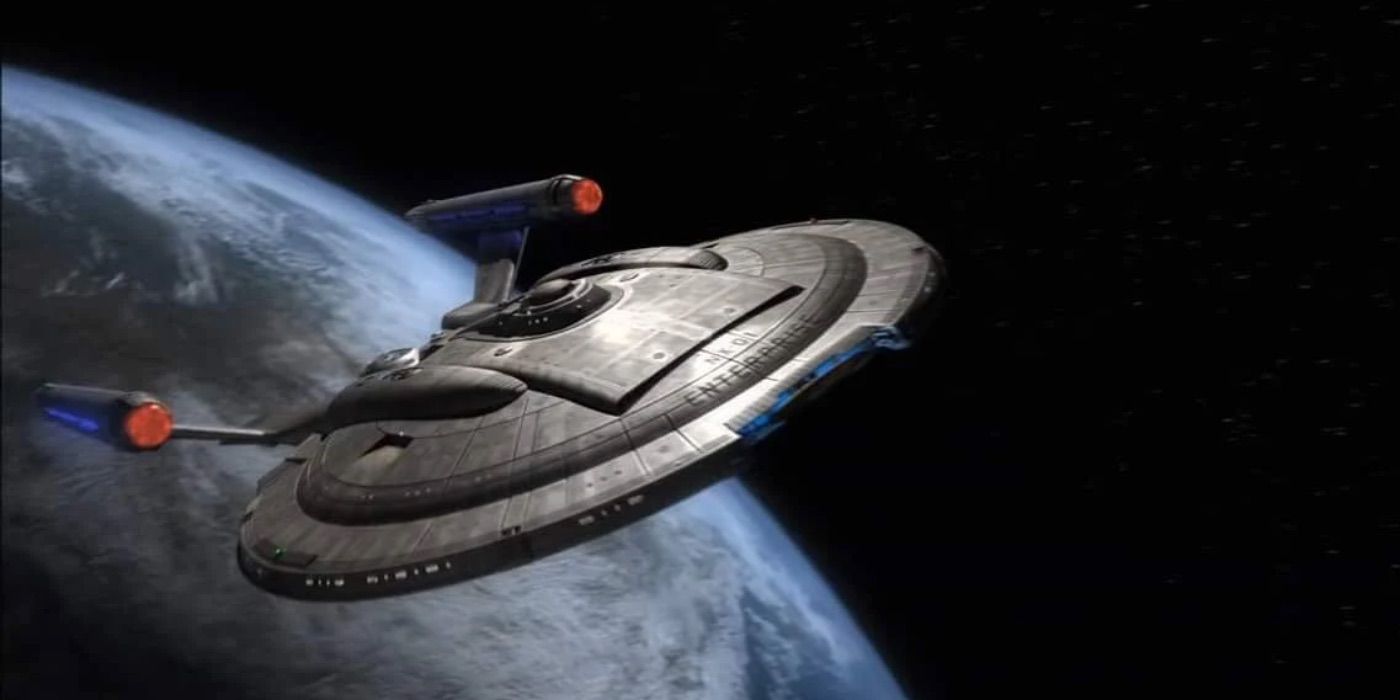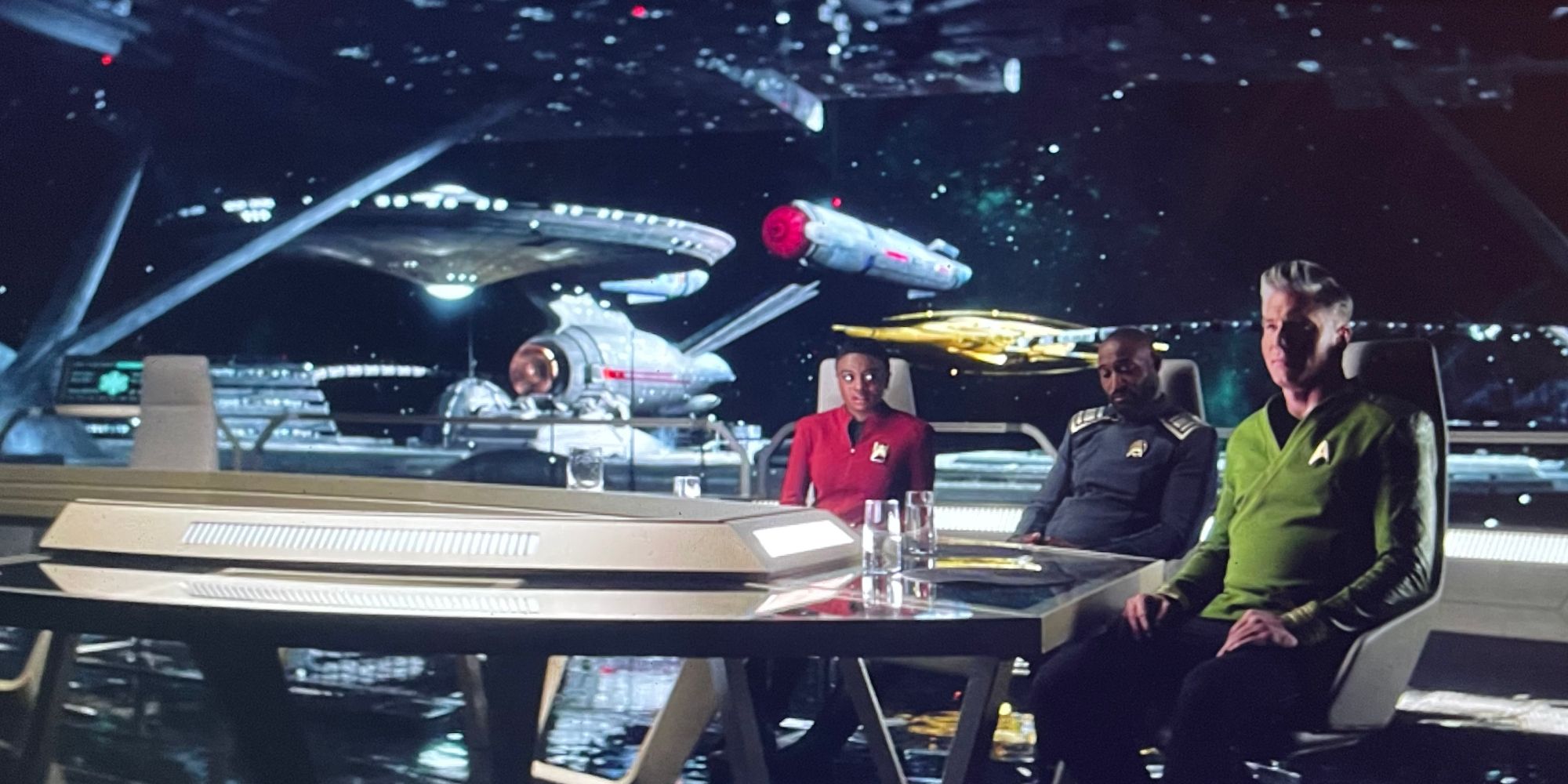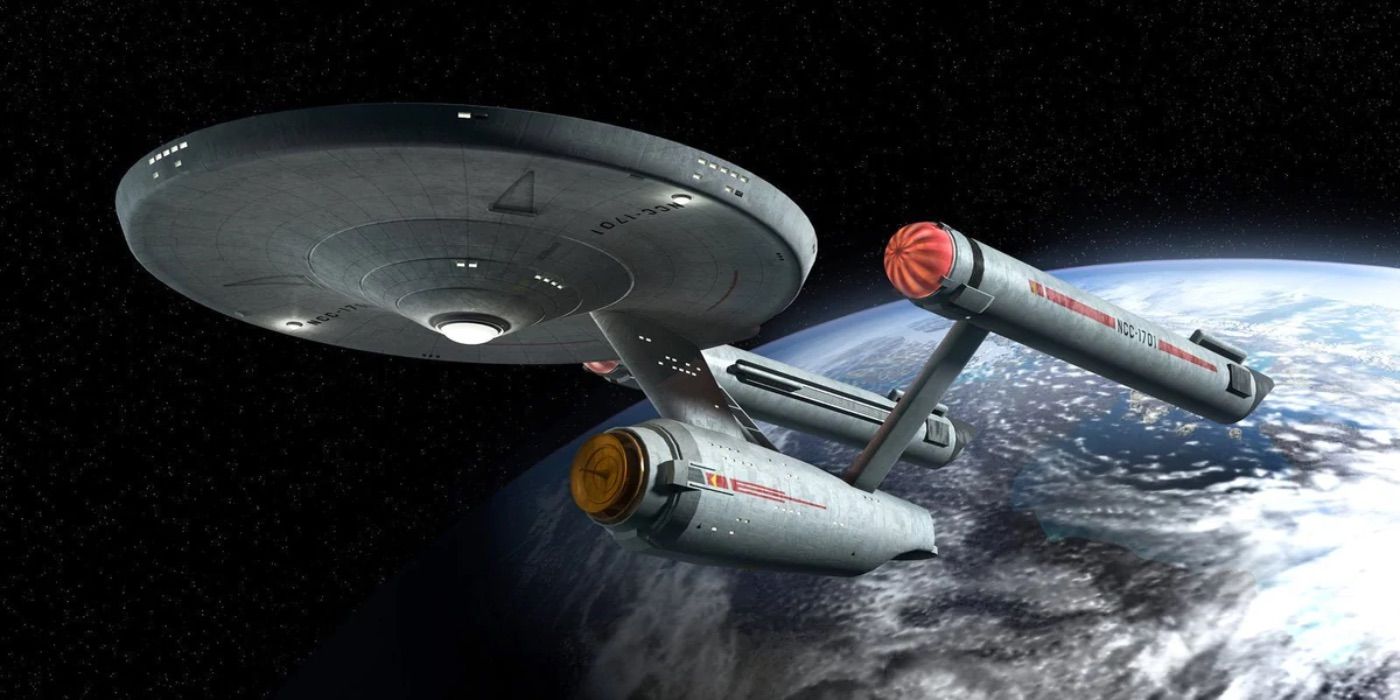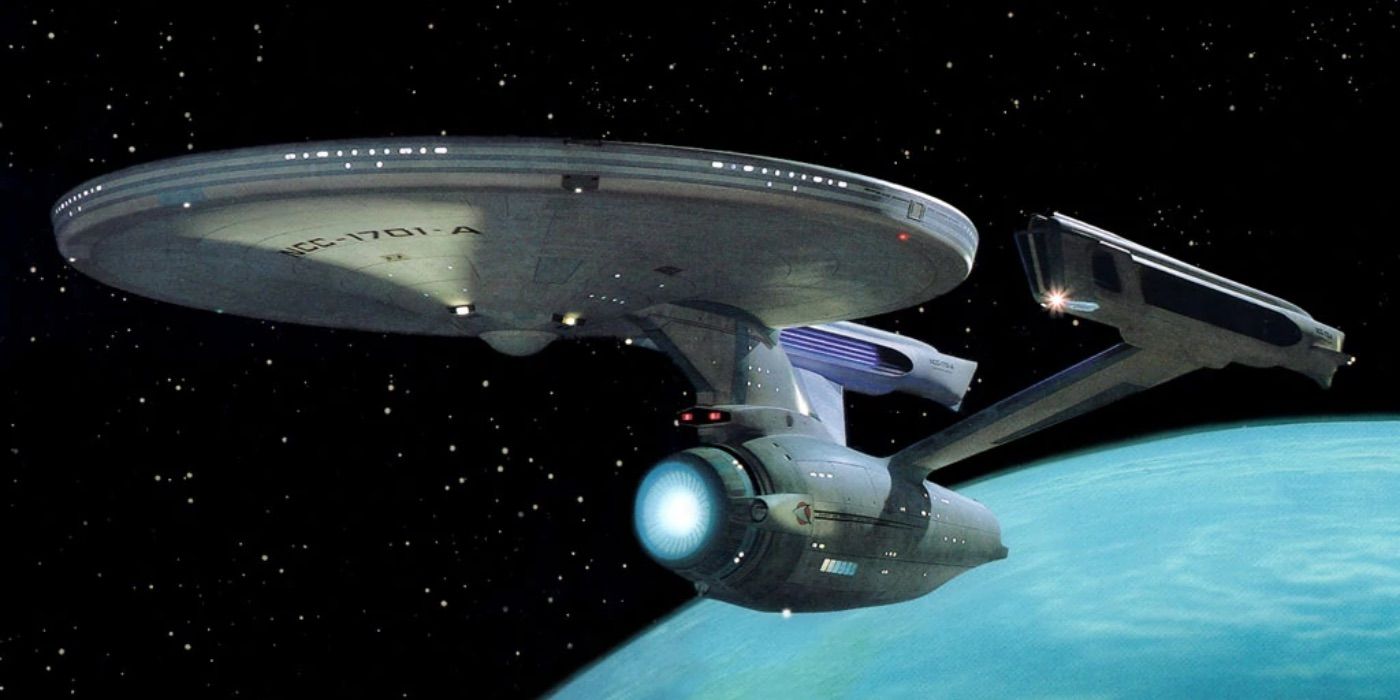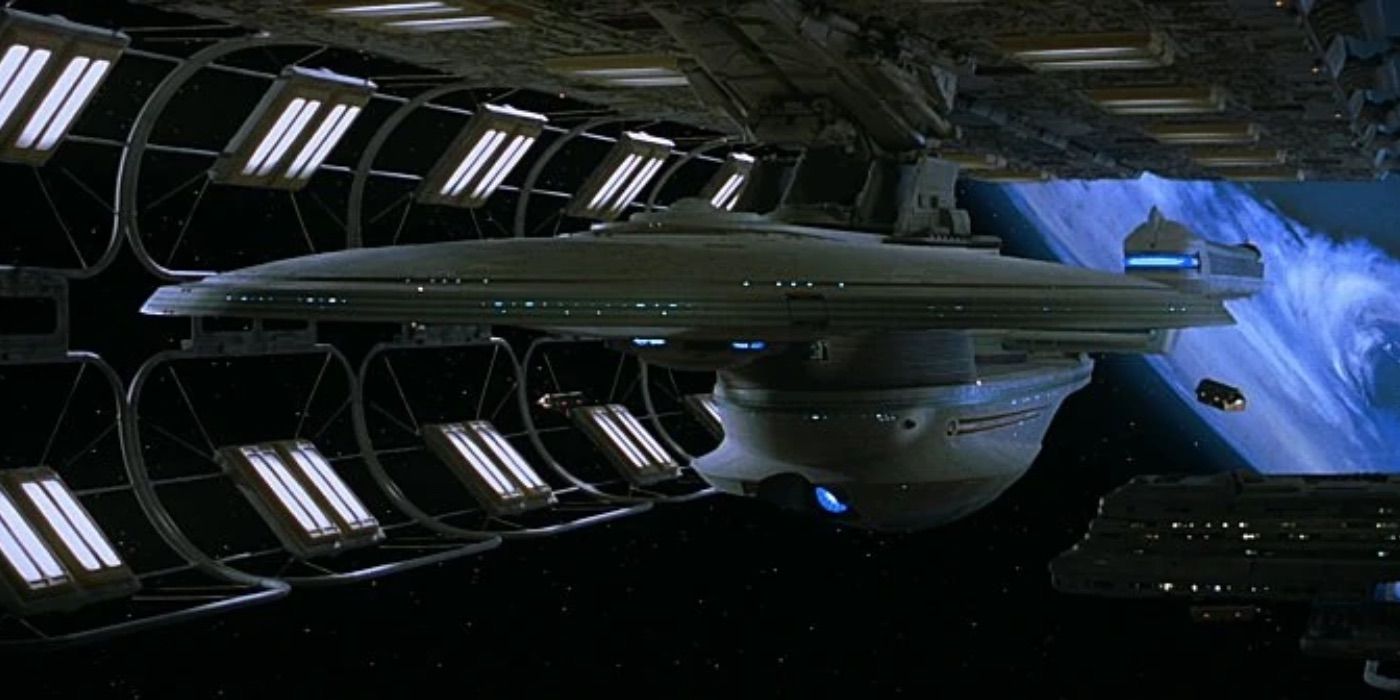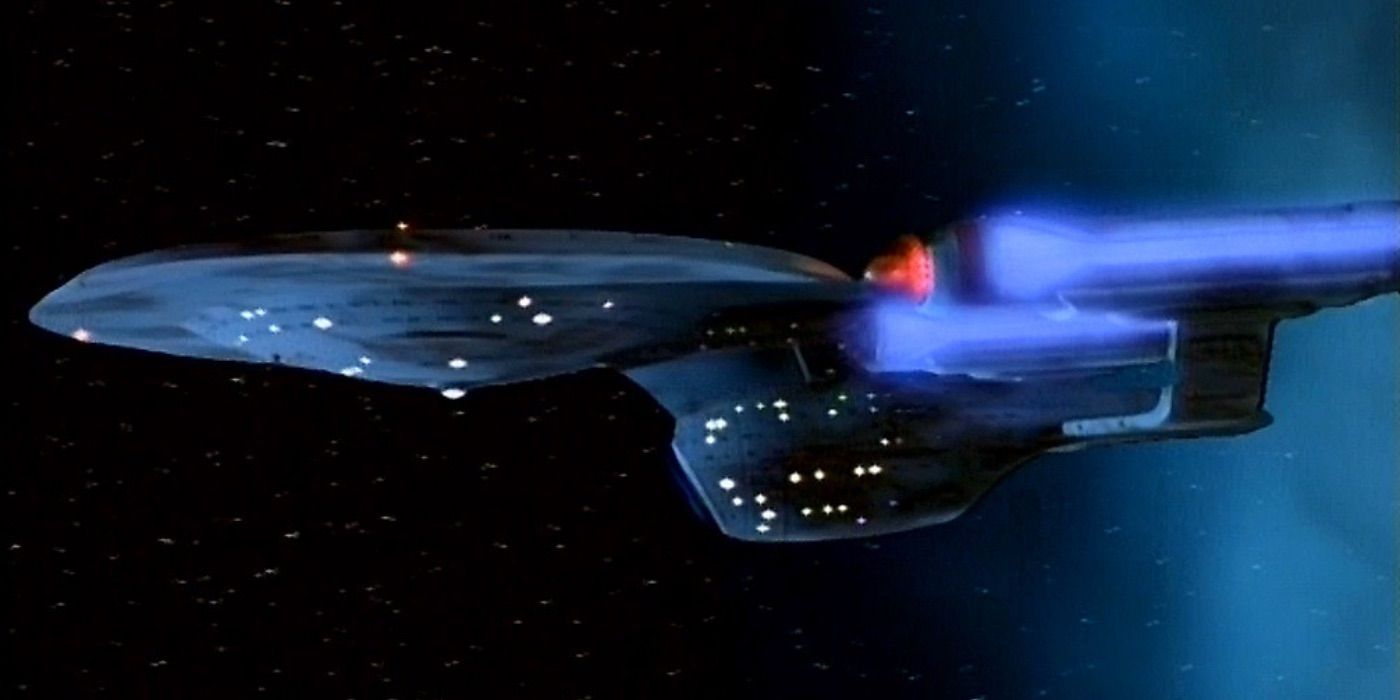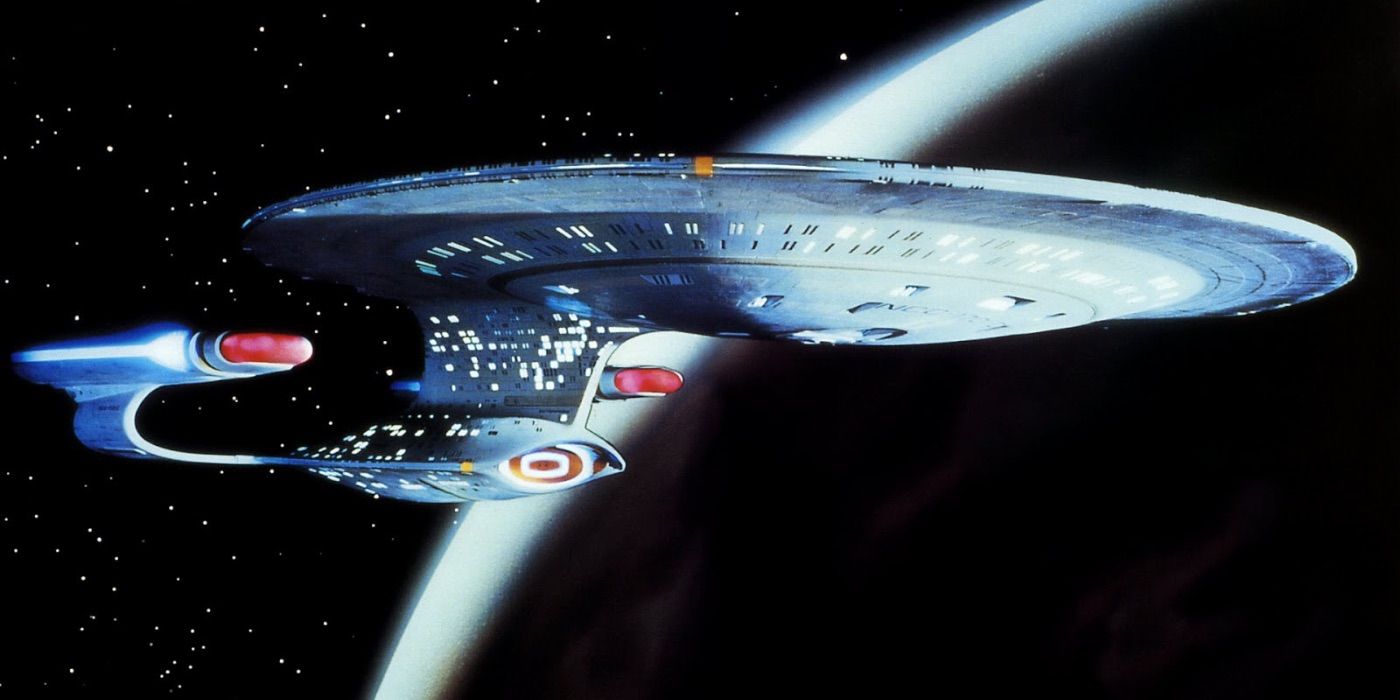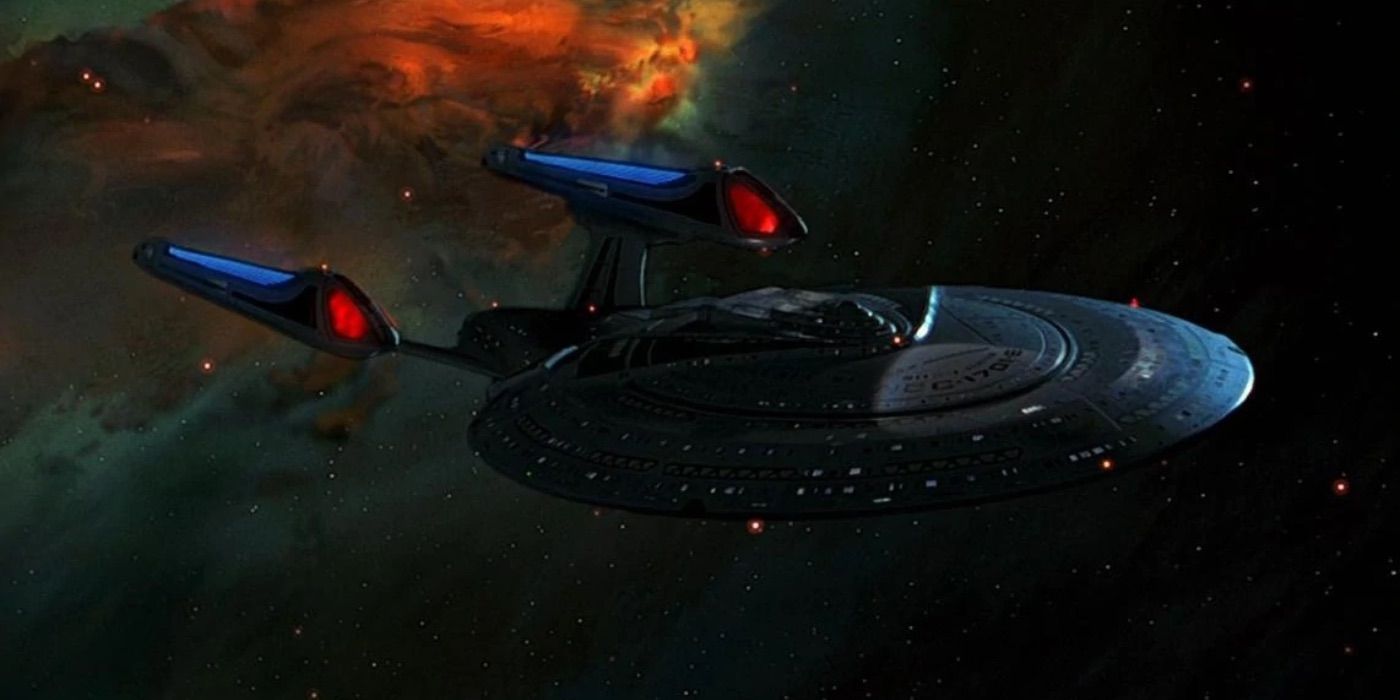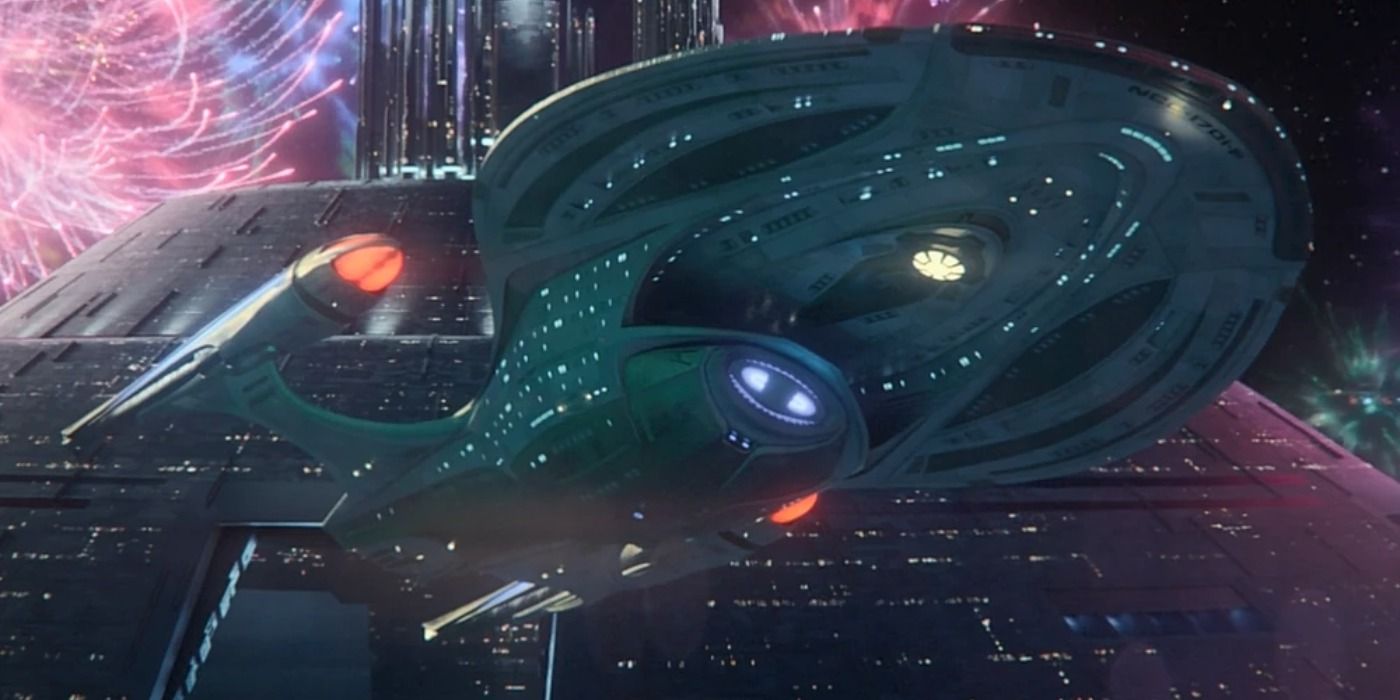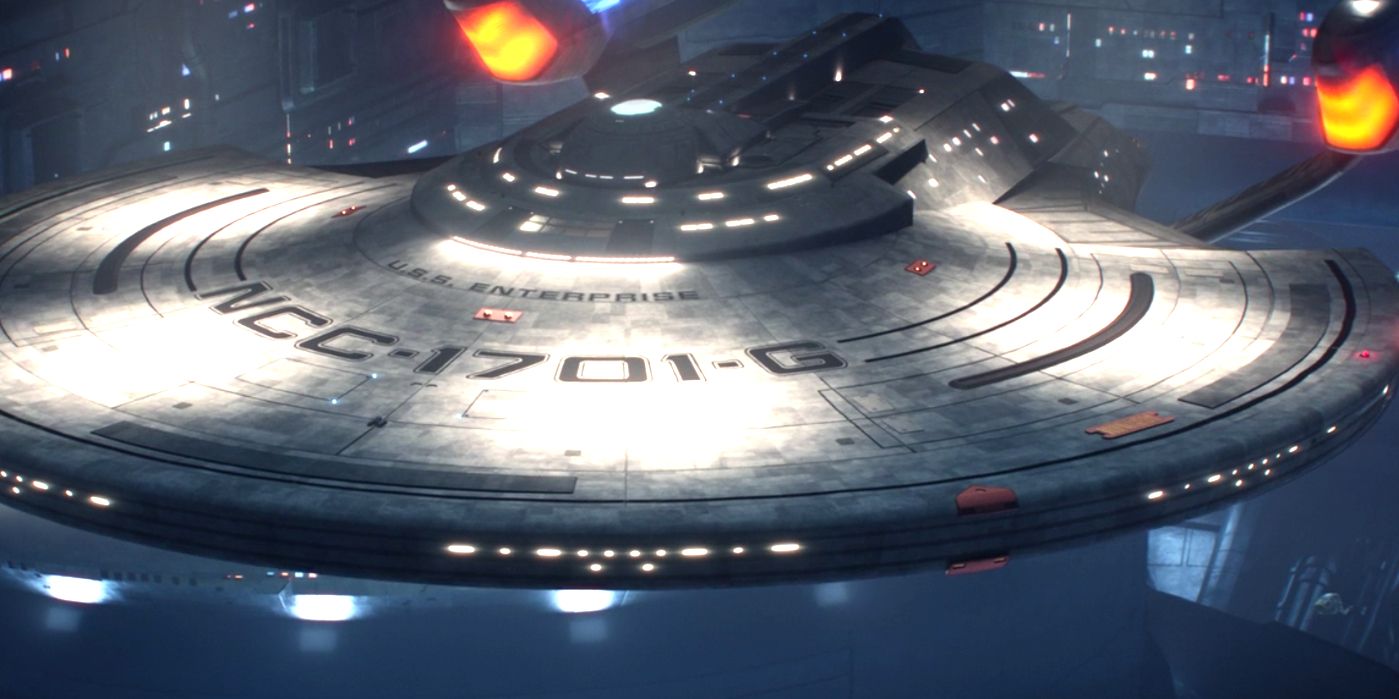There have been nine versions of Star Trek's signature spacecraft, the USS Enterprise, and here's every starship to bear the iconic name. Home to some of the most exciting adventures in the Star Trek franchise's illustrious history, the Enterprise is also one of the most recognizable ships in science fiction history, even though it has gone through a lot of changes since its debut in Star Trek: The Original Series. Generally maintaining its signature saucer and nacelles look, the specifications of each version of the Enterprise have seen it grow and change with each major refit — still, it's always been the Federation's flagship no matter what era it flew in.
The Enterprise first appeared in Star Trek: The Original Series but was already a veteran of the Federation fleet by the time Captain Kirk and his crew went on their first five-year mission. The history of Starfleet is inextricably tied to the Enterprise, and each show makes it clear that she's the top of the line. Going as far back as the events of Star Trek: Enterprise, the titular vessel was the first to attempt deep space exploration during the course of the prequel series, but small clues alluded to the fact that an Enterprise was always a part of space travel, long before Captain Archer first donned his uniform.
Pre-Federation Enterprises (Star Trek: Enterprise)
Excluding the real-life space shuttle launched by NASA in 1977, the oldest known example of a space-faring ship to bear the Enterprise name was briefly hinted at during Star Trek: Enterprise. Seen in Star Trek: Enterprise season 2, episode 24, "First Flight," a painting of the USS Enterprise XCV 330 revealed it to be a probe-like vessel with a long tube body that was surrounded by massive orbiting rings. Far from the most powerful Starfleet ship, the XCV 330's design was primitive even by Enterprise-era standards, and little has been revealed in canon about the specification or history of the vessel.
Launched in the year 2150, the Enterprise NX-01 was captained by Jonathan Archer until the year 2161 and was the setting for the series Star Trek: Enterprise. The hull of the NX-01 consisted of a massive saucer section that tapered off into two nacelles that were in line with the saucer and gave the ship a sleeker profile compared to later incarnations of the Enterprise. Helping Captain Archer make crucial first contacts during his tenure, the NX-01 was the top of the line for its era and was the first Earth starship capable of reaching warp five, which came in handy during the formation of the United Federation of Planets.
USS Enterprise NCC-1701 (Star Trek: Strange New Worlds)
After the formation of the United Federation of Planets, the Enterprise NX-01 was scuttled because it was woefully behind the times compared to the superior technology of the Vulcans. As such, the Enterprise name sat dormant until the creation of the Constitution class of starship where the USS Enterprise NCC-1701 was launched in 2245. The Enterprise was first commanded by Captain Robert April (Adrian Holmes), under whom Commander Christopher Pike served as the ship's Number One. Pike assumed command of the Enterprise five years later and led the Federation flagship for almost 15 years.
Star Trek: Strange New Worlds depicts the final five-year mission of Captain Christopher Pike (Anson Mount) before he cedes the Captain's chair to James T. Kirk (William Shatner). Due to the real-world changes in television production, Pike's Enterprise has some subtle differences to Kirk's TOS starship. The nacelles are a slightly more vibrant red, while the exterior of the ship seems better lit than its successor. It's also been noted that Pike's Enterprise is bigger than Kirk's, suggesting that a refit takes place between Strange New Worlds and Star Trek: The Original Series.
USS Enterprise NCC-1701 (Star Trek: The Original Series - Star Trek III: The Search For Spock)
Kirk's two five-year missions between 2265 and 2280 are the stuff of Starfleet legend. Star Trek: Strange New Worlds' season 1 finale confirmed that, without Captain James T. Kirk, the Federation would have become involved in a brutal war with the Romulan Star Empire. Twenty years after the starship first launched, Kirk's Enterprise showed no signs of its age as it conducted its two five-year missions, battling Romulans, Klingons, and encountering innumerable strange stellar phenomena.
Much larger than its predecessor, the NX-01, the Enterprise NCC-1701 also sported a massive saucer section and nacelles but featured a secondary hull that sat below the saucer for a less aerodynamic design. Various refits throughout its lifetime updated the look of the ship, and by the events of the first Star Trek movie, the Enterprise had an updated interior. After Kirk, two other men captained the Enterprise 1701: Spock and the brief tenure of Willard Decker. However, the eventual self-destruction of the vessel, enacted by Kirk in Star Trek III: The Search for Spock, was a fitting end to her 40 years of service.
USS Enterprise NCC-1701-A (Star Trek IV: The Voyage Home - Star Trek VI: The Undiscovered Country)
Following the total destruction of the Enterprise NCC-1701 in Star Trek: The Search for Spock, Kirk was "demoted" back to captaincy and given an entirely new USS Enterprise in the form of the commissioned NCC-1701-A in 2286. Almost identical in look and technical specifications to its predecessor, the Enterprise-A was beset with technical problems, as seen during the events of Star Trek V: The Final Frontier. Kirk was the only person to captain the vessel in its seven-year service period, and the vessel was decommissioned after Star Trek VI: The Undiscovered Country. Star Trek: Picard season 3 revealed Kirk's Enterprise-A as one of the exhibits in the Athan Prime Fleet Museum.
USS Enterprise NCC-1701-B (Star Trek: Generations)
The NCC-1701 and 1701-A were the top of the line during their tenures, but the emergence of the Excelsior class of starship in Star Trek: The Search for Spock showed that the Constitution class had become a Starfleet dinosaur. In Star Trek Generations, the USS Enterprise NCC-1701-B was launched under the new Excelsior class and captained by John Harriman in 2293. The ship's saucer section was flattened along with the removal of the neck between the two hulls for a streamlined look. After the apparent death of Captain Kirk during its first flight, the rest of the history of the NCC-1701-B was captured in non-canon stories, but her impressive 36-year service period almost surpassed that of the original NCC-1701 in length.
USS Enterprise NCC-1701-C (Star Trek: The Next Generation)
Despite only appearing in Star Trek: The Next Generation, season 3, episode 15, "Yesterday's Enterprise," the NCC-1701-C is nevertheless one of the most important incarnations of the ship. The NCC-1701-C was destroyed in 2344 while defending the Klingon outpost Narendra III during an attack from the Romulans. It was an Ambassador class ship that replaced the streamlined look of the NCC-1701-B with a longer neck, and the NCC-1701-C featured a tubular secondary hull that was reminiscent of its predecessors. While little is known about the ship, its service was integral in the Federation forging an alliance with the Klingons.
USS Enterprise NCC-1701-D (Star Trek: The Next Generation)
The Enterprise grew in scale with each subsequent redesign, and the USS Enterprise 1701-D joined Starfleet as the largest vessel to ever sport the name, dwarfing the familiar and classic NCC-1701 model. The most notable starship from Starfleet's impressive Galaxy class, the Enterprise-D was the setting for the events of Star Trek: The Next Generation and was commissioned in 2363. Captained only by Jean Luc Picard (Patrick Stewart) during its eight years in deep space, the enhanced technology of the Enterprise-D allowed her to be a TNG character all of her own, and her impressive firepower made her a formidable force in the galaxy.
The oval design of the Enterprise's removable saucer section was in stark contrast to the circular design of previous ships, and the secondary hull dropped the tubular structure in favor of a flattened and wide look. She was eventually destroyed during the events of Star Trek: Generations and yet her sub-decade tenure was packed with more important events than many of the previous Enterprises combined. Commodore Geordi La Forge (LeVar Burton) lovingly restored the Enterprise-D, and it now sits pride of place in the Fleet Museum after saving the galaxy one last time in Star Trek: Picard season 3.
USS Enterprise NCC-1701-E (Star Trek: First Contact - Star Trek: Nemesis)
Though previous starship classes lasted for generations, the upgrades of the post-TNG era saw a new class every few years. To replace the Enterprise-D following Star Trek: Generations, the Sovereign class Enterprise NCC-1701-E was commissioned under the command of Captain Jean-Luc Picard in 2372. Sent back in time to defeat the Borg during the events of Star Trek: First Contact, the Enterprise-E minimized the lower hull and brought the nacelles in line with the saucer for a narrow body that matched the warlike tone of post-TNG Star Trek.
Picard's Enterprise-E largely avoided Star Trek: Deep Space Nine's Dominion War, with the Captain noting his frustration at this in Star Trek: Insurrection. However, the Enterprise did find itself on the fringes of the conflict during Insurrection when they confronted the So'na - manufacturers of the ketracel white used to control the Jem'Hadar. Picard left the Enterprise-E to lead a rescue armada to assist with the evacuation of Romulus during the supernova disaster. Picard was succeeded by Captain Worf (Michael Dorn), but not much is known about his time in command. All that's known is Worf's Enterprise-E disaster which seemingly left the starship completely destroyed.
USS Enterprise NCC-1701-F (Star Trek: Picard)
The Odyssey-class USS Enterprise NCC-1701-F was launched in 2386 and was slated for early decommissioning as part of Starfleet's Frontier Day celebrations in 2401. Not much is known about the starship, beyond the fact that several Captains commanded the starship over its 15 years of service. The starship's final ceremonial flight was commanded by Admiral Elizabeth Shelby (Elizabeth Dennehy) before her tragic death at the hands of the Borg. As Picard and the crew of the restored Enterprise-D destroyed the Borg signal, severing the connection to the assimilated Starfleet, it's likely that the Enterprise-F is now stored at the Fleet Museum after the end of Star Trek: Picard season 3.
USS Enterprise NCC-1701-G (Star Trek: Picard)
Star Trek: Picard brought the story of the Enterprise full circle, by restoring it to Constitution-class status. In 2402, the Constitution III-class USS Enterprise NCC-1701-G launched, having undergone an extensive refit. The refit turned the USS Titan-A into the Enterprise-G, out of respect for Picard and the crew's heroic actions during the Borg and Changeling attack during Picard season 3. The Enterprise-G is commanded by Captain Seven of Nine (Jeri Ryan) who is joined by Ensign Jack Crusher (Ed Speleers), son of legendary Enterprise Captain, Jean-Luc Picard. It's clear, therefore, that the name Enterprise will continue to be associated with diplomacy, heroism, and exploration long into Star Trek's future.


